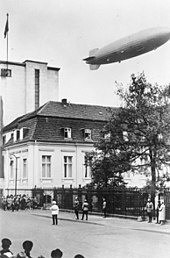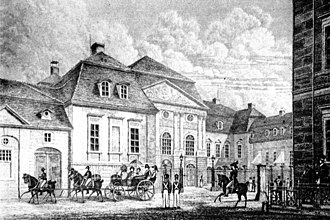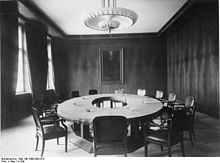Reich Chancellery
The Reich Chancellery was the authority of the Reich Chancellor of the German Reich from 1878 to 1945. The authority was primarily responsible for the Reich Chancellor's dealings with the other Reich and state organs . A state secretary was responsible for the management . Your official building was a palace at Wilhelmstrasse 77 in Berlin . The Reich had acquired it in 1875 at Otto von Bismarck's insistence as the seat of the Reich Chancellery. The building was named after the client "Palais Schulenburg" or the family of the last purchaser Antoni Henryk Radziwiłł "Palais Radziwill" or after the function "Reich Chancellor Palace " and from 1930 after a redesign also "Old Reich Chancellery" .
The Reich Chancellery was sometimes called the "Reich Chancellery". It is not to be confused with the actual Federal Chancellery of the North German Confederation , which has been called the Reich Chancellery since 1871 . It developed into the Reich Office of the Interior.
Start time


The building of the Old Reich Chancellery was built by Carl Friedrich Richter in 1738/39 . In 1869 Bismarck bought the palace for the purposes of the Prussian state government. In 1875, the German Empire acquired the building, which in future served as the residence and official residence of the respective Reich Chancellor. In the years 1875–1878, the interior of the building was converted according to plans by Wilhelm Neumann . From 1878 Bismarck used the palace as his residence and the newly established central office of the Reich Chancellor moved into the palace with him. Bismarck also proposed that the palace be renamed the Reich Chancellery .
The Reich Chancellery as the headquarters of the Federal Chancellor should not be confused with the North German Federal Chancellery from 1867, which was renamed the Reich Chancellery in 1871. The Reich Chancellery was the forerunner of the Reich Office of the Interior , later the Ministry of the Interior.
In 1878 the Berlin Congress met in the ballroom in the middle of the upper floor, which negotiated a settlement of the previous Balkan crisis with Bismarck's mediation . The Congo Conference (1884/1885), which regulated the colonial division of Africa , also took place here.
Between 1928 and 1930, an extension was built on the neighboring property at Wilhelmstrasse 78. The State Secretary of the Reich Chancellery was in charge of the relevant preparatory work. There was an invitation competition for the building to be constructed in the spring of 1927, which aimed to close the gap between the existing office building and the Palais Borsig in a stylistically adapted manner. More than 200,000 marks were available for the necessary work (adjusted for purchasing power in today's currency: around 715,000 euros). The architects Eduard Jobst Siedler and Robert Kisch were the winners of the competition and their plans were largely implemented.
The Reich Chancellor's Palace was temporarily the official residence of President Paul von Hindenburg between 1932 and 1933 , as Hindenburg's apartment in the Reich President's Palace (Wilhelmstrasse 73) was being renovated at that time . Although he had to give up his post as Chancellor on December 3, 1932, Franz von Papen stayed in his official apartment and thus had repeated direct contact with the aged head of state and members of the camarilla . The new Chancellor Kurt von Schleicher still lived in his apartment in the Bendlerblock .
Later use
In 1934/1935, the living and working rooms for Adolf Hitler , the Fiihrer's apartment , were renovated and refurbished by Paul Ludwig Troost , Gerdy Troost and Leonhard Gall . The architects relocated the representative rooms for receiving guests from the first floor to the ground floor. In the old corps de logis (central building) of the palace, this housed the salon on the garden side and the newly built hall building with a large dining room for diplomatic receptions and a winter garden . The cabinet room was moved from the extension (1930) back to the conference room on the upper floor of the central building. After the completion of the New Reich Chancellery , the cabinet room was moved there, while the conference room was mostly unused, only Hitler's birthday presents were put up here every year. In addition, Hitler's private study, his bedroom with bathroom and Eva Braun's room were on the first floor . On the garden side, an air raid shelter was built under the dining room and winter garden , the "pre- bunker " of the later Führerbunker .
According to plans by Hitler's house architect Albert Speer , the New Reich Chancellery was built along Vossstrasse in 1935–1943 ; a new building which, with its monumental dimensions of 421 meters in length, was intended to reflect the National Socialists' claim to power. The official inauguration of the partially unfinished structure took place on January 10, 1939. From 1943, the Führerbunker was laid out in the garden of the Old Reich Chancellery to the west of the hall building .
In 1945, the Old Reich Chancellery was badly damaged in the Second World War . On October 13, 1948, the Soviet Military Administration in Germany (SMAD) ordered the building complex of the Borsig Palace and the Alter and New Reich Chancellery associated with the Nazi regime to be demolished because it could have become a place of pilgrimage for right-wing extremists . The ruins of the Old Reich Chancellery were then removed in the course of 1949.
See also
- Small Reich Chancellery in Berchtesgaden
- New Reich Chancellery
- List of State Secretaries in the Reich Chancellery
- Reich Cabinet Council
literature
- Thomas Sandkühler : The Reich Chancellery in Wilhelmstrasse 1871–1945 and Adolf Hitler's “Führer Apartment”: History of a forgotten place . In: Susanne Kähler , Wolfgang Krogel (Ed.): The Bear of Berlin. Yearbook of the Association for the History of Berlin . 65th year, Berlin 2016, pp. 101-138.
- Laurenz Demps : Berlin-Wilhelmstrasse. A topography of Prussian-German power . 3rd updated edition. Ch.Links, Berlin 2000, ISBN 3-86153-228-X .
- Sonja Günther: Design of Power. Furniture for representatives of the “Third Reich”. Deutsche Verlags-Anstalt, Stuttgart 1992, ISBN 3-421-03029-4 .
- Dietmar Arnold, Reiner Janick: New Reich Chancellery and “Führerbunker” - Legends and Reality . Ch. Links Verlag, Berlin 2005, ISBN 3-86153-353-7 .
- Hans Günter Hockerts: Base camp of research: The edition of the files of the Reich Chancellery (PDF; 447 kB). About the preserved files of the Reich Chancellery. (In: badw.de 2005. Overview of an important source publication, see link under web links)
- Manfred Neumann: From the Reich Chancellery to the Federal Chancellery - 120 years ago: Bismarck founded the Reich Chancellery . In: AöR , Vol. 124, 1999, pp. 108-130.
- Christoph Neubauer: The Reich Chancellery - Architecture of Power , Vol. 1 (1733-1875). Chr. Neubauer Verlag, Großschönau 2014, ISBN 978-3-9813977-1-0 .
- Andreas Nachama (ed.): Wilhelmstrasse 1933–1945 - the rise and fall of the NS government district . Topography of Terror Foundation , 2012, ISBN 978-3-941772-10-6 , p. 45 ff.
Web links
- Online version of the edition “Files of the Reich Chancellery. Weimar Republic"
- 3D animation of the New Reich Chancellery
- The Palais Radziwill . Contribution to Porta Polonica . Documentation center on the culture and history of Poles in Germany , requested on April 28, 2020
Individual evidence
- ^ Ernst Rudolf Huber: German constitutional history since 1789 . Volume III: Bismarck and the Reich. W. Kohlhammer, Stuttgart a. a. 1963, p. 832/833 .
- ↑ Extension of the Reich Chancellery . In: Vossische Zeitung , January 19, 1927, morning edition; P. 5.
- ^ Rüdiger Barth and Hauke Friedrichs: The gravedigger. The last winter of the Weimar Republic. Ulstein, Berlin 2018, p. 145-46 .
- ↑ 3D model of the Reich Chancellery : 15 = old Reich Chancellery, 18 = extension building 1930, 14 = hall building 1935, red = bunker, left 1943, right 1935, 1/2/3 = new Reich Chancellery 1939
Coordinates: 52 ° 30 ′ 42 " N , 13 ° 22 ′ 55" E


